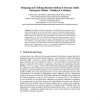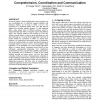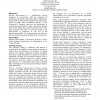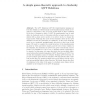2102 search results - page 57 / 421 » A Relational Model for Object-Oriented Designs |
MOBIS
2008
13 years 10 months ago
2008
Abstract: The design of effective indicators and indicator systems requires a profound understanding of the relevant business context. Numerous relations and dependencies within an...
GROUP
2003
ACM
14 years 2 months ago
2003
ACM
In order to support co-located collaboration, many researchers are now investigating how to effectively augment tabletops with electronic displays. As far back as 1988, orientatio...
CHI
1997
ACM
14 years 1 months ago
1997
ACM
the changing roles of participants in a musical improvisation and synchronously generate appropriate contributions of its own. Musical improvisation is a collaborative activity ana...
ICMT
2009
Springer
14 years 3 months ago
2009
Springer
Abstract. The QVT Relations (QVT-R) transformation language allows the definition of bidirectional model transformations, which are required in cases where a two (or more) models ...
SIGCSE
2000
ACM
14 years 1 months ago
2000
ACM
Classifying is a central activity in object-oriented programming and distinguishes it from procedural programming. Traditional logic, initiated by Aristotle, assigns classificatio...




